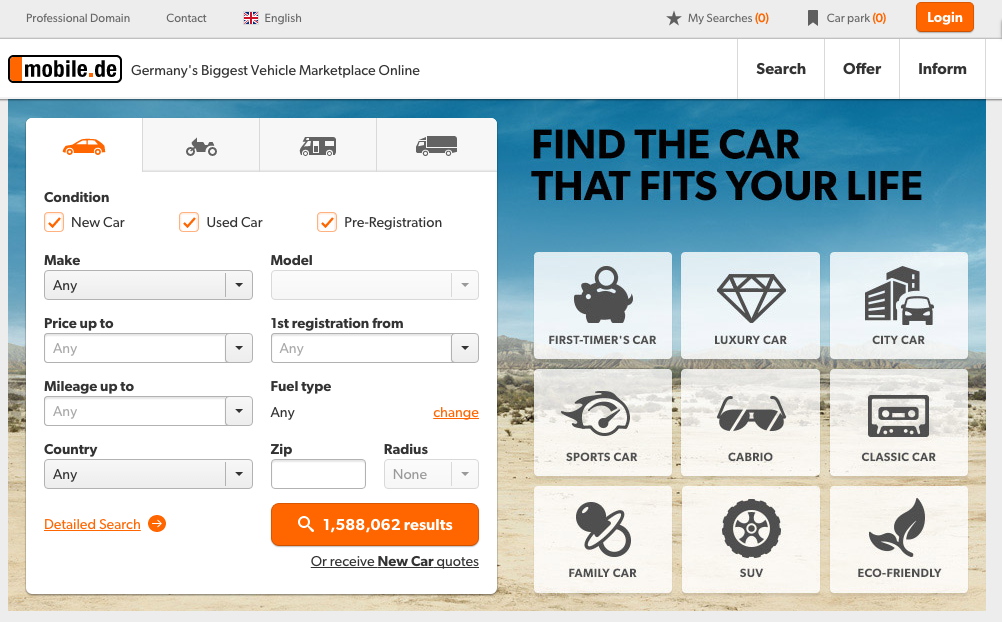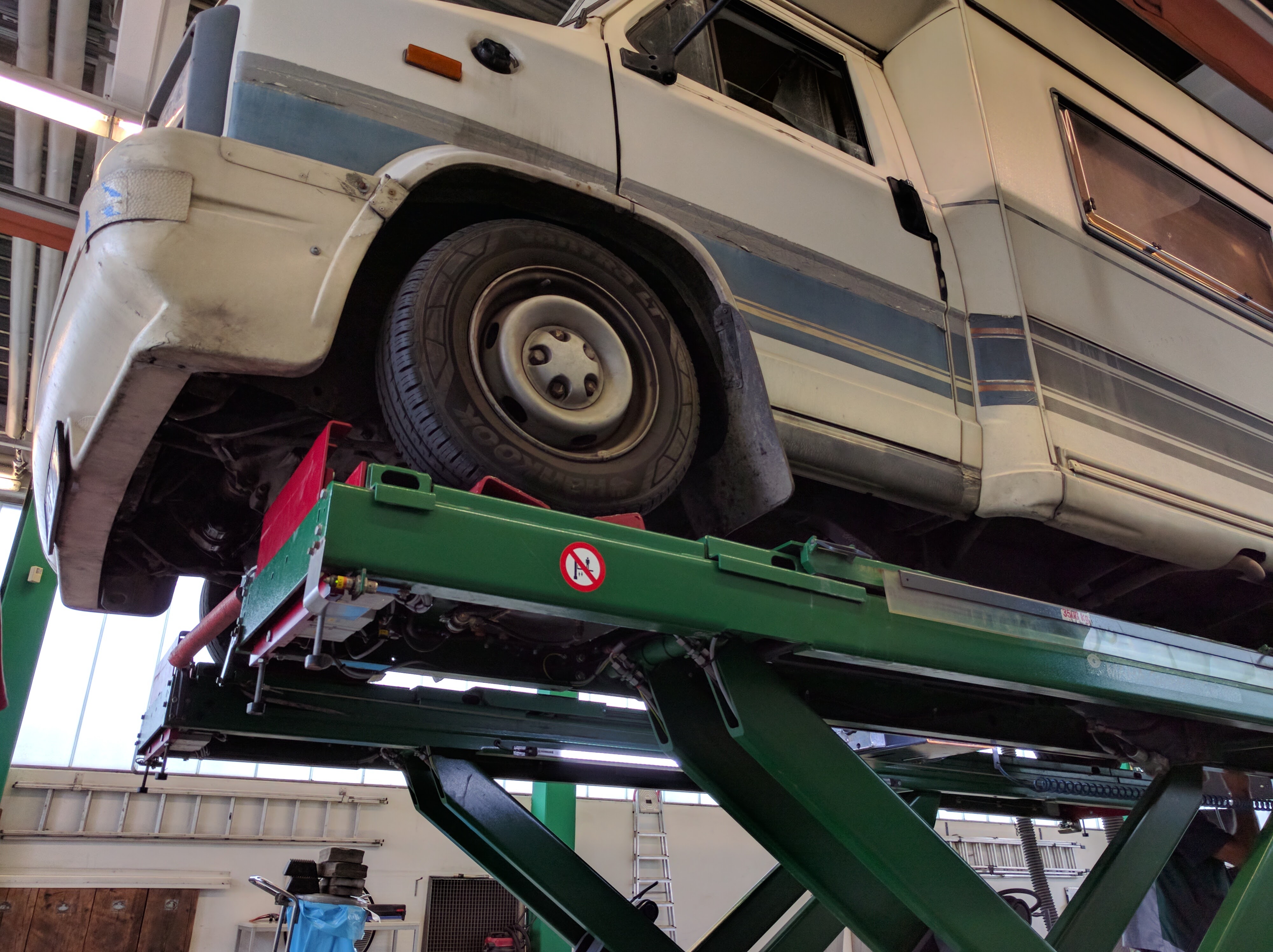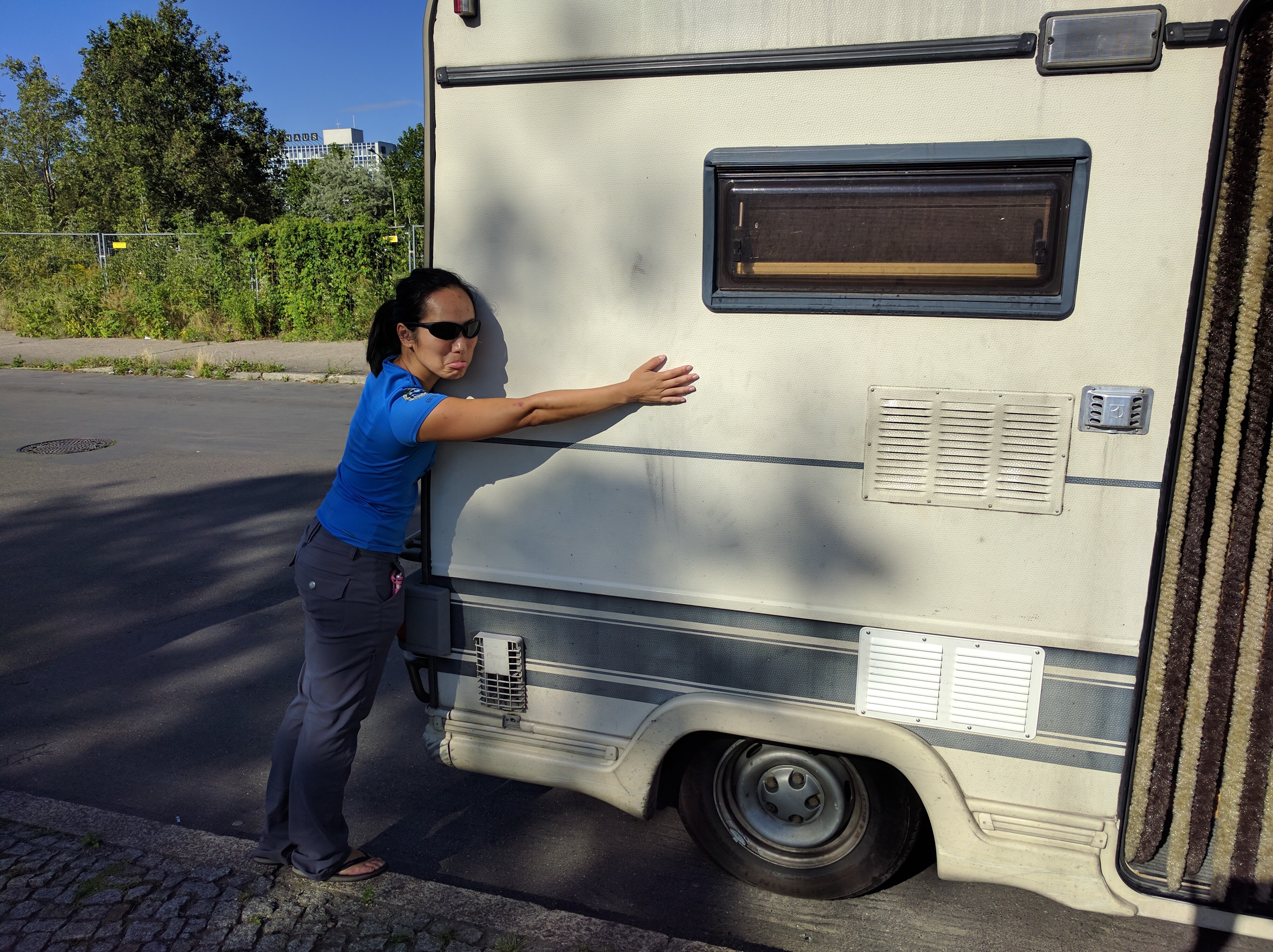We sure learned a lot after searching, buying, registering, driving, and living in a RV in Germany and throughout Europe, and then advertising, selling, and transferring the RV when we finished the journey. I hope the information below helps anyone interested in embarking on an epic road trip in Europe.
But first, here are the must-do’s before leaving the U.S.:
- Know how to drive a manual transmission vehicle. Chris and I had already broken the American stereotype by having previously owned manual transmission cars–Yay! Most vehicles (including RVs) in Europe are manual transmission. I certainly didn’t see any automatic options when searching for a RV.
- Make sure you have a valid visa. If staying less than 90 days, then it’s not an issue, but if staying over 90 days, read and understand the Schengen zone rules for U.S. citizens. Because we spent 6+ months in Europe, we solved the Schengen issue by getting French long term stay visas. That process is described here.
- Purchase an international driver’s license, available for $15/year at a AAA office. No one ever asked to see our IDL, but we mainly bought them for insurance reasons.

Okay, now which country to buy in? We picked Germany for the following reasons:
- Compared to other countries, there seems to be the most online resources for Germany. I don’t understand why. With all the useful information, tips, and help online, it made easier to find answers to my questions.
- The UK was also another popular country to purchase a RV, but it is much cheaper to buy a RV in Germany (euros) than in the UK (pounds). When comparing prices and doing money conversions in early 2016, we saw that buying a RV in Germany would easily save us at least $1,000.
- German RV’s and vehicles are all left-hand drive–important if driving all around Europe!
- There are plenty of options! Germans are known to embrace the outdoor life; it is no surprise that RV culture in Germany is strong.
- Perhaps the only plus side to buying in the UK is that everyone speaks English, but at least a large percentage of Germans (roughly 40%) speak English.
- We had a free place to stay in Berlin while searching for a RV. A Berliner friend of ours was out of town and offered up his apartment to us. I know most people won’t be as fortunate, but this was another nice reason for us to start in Berlin.

What kind of RV?
- There is always the debate over integrated RV vs. tow vehicle (TV) + trailer. We own a TV + trailer in the states, which makes sense for us in the states because of America’s vast wilderness. However, we knew we wanted a semi-integrated RV in Europe for obvious reasons: we didn’t want to have to buy a TV and a trailer, and we’d be driving in cities so we needed something small(ish).
- Diesel fueled RVs are common in Europe, which draws the question: diesel or gas? Let me tell you: DIESEL! Not only is diesel more efficient than gas, it is also cheaper in almost all European countries. If you do end up with a diesel RV, make sure you know how to start it, drive it, and maintain it. Oil changes and air and fuel filter replacements should be done every 12-15,000 km, which may seem excessive, but we put in a lot of kilometers in a very short time.
- Obviously, pick a RV with options that suit your needs. Because we were living in it for 6 months, we needed everything: bed/table configuration, 2-burner stove, fridge, heater, hot water, toilet, and shower. We couldn’t find a motorhome with an AC (we only suffered 1-2 weeks of the entire 6 months anyway), and Chris wishes we bought a RV with power steering.

How to find a RV?
- Mobile.de is the most popular site. Ebay comes close too, but mobile.de is more widely used by a long shot.
- On a side note, the tiny, incredible country of the Netherlands seems to have a number of businesses offering a sell and buy-back scheme of RVs to foreigners. While I have not had any first-hand experiences with any of the businesses, Happy Campers, BW Campers, and Dutch Campervans are all companies that seem to be widely used by adventurers looking to road trip Europe. Comments on social media show that people were happy to easily purchase a RV and insurance, and hand over the keys when finished–all without the stress of finding a new buyer. However, after a quick peek at some of these sites, I found that most of the RVs for sale were beyond our budget ($8,000+). With the negotiable buy back of 40%-60%, we preferred to buy and sell our motorhome independently because I heard we’d be able to resell at most if not all the original cost.

Questions to ask and things to look for when shopping?
- Make sure the HU/AU report (nicknamed the TÜV), which is the vehicle road-worthy certificate, is still valid. In Germany, vehicle owners must perform HU/AU inspections every 2 years. If it passes, then the vehicle is good for the road another 2 years. If it doesn’t pass, you’ll have to repair the damages listed on the report, and redo the inspection. The inspection alone costs 100€+. If the vehicle of interest has a HU/AU report that lasts the duration if your travel, then that’s perfect! If the vehicle of interest has a HU/AU report that will expire during your travels, you’ll need to consider if doing the report yourself + paying for the costs of possible repairs would be worth your time. If the vehicle of interest has an expired HU/AU report, DO NOT BUY IT. Chances are there is something wrong with it, and the owner doesn’t want to deal with the repairs.
- Like with any vehicle, try to find one with low mileage. You’ll be putting thousands of kilometers more in the RV, which you’ll need to consider when reselling.
- In addition to making sure that all the appliances work, check for rust/damage beneath the vehicle!!! Unfortunately we learned this the hard way. When we took our RV in for the HU/AU inspection, we sadly discovered that the entire right side of our RV’s flooring was rotted–the previous owner didn’t tell us about this damage, nor did we look at it before buying. We were quoted 1,500-2000€ just for the floor alone, which forced us to sell our RV at a severely reduced price. This sucked big time, because we had plenty of interested buyers even when we listed it for the same price we bought it for.
- Inquire about the previous timing belt replacement. We were asked about the timing belt, or Zahnriemen, multiple times when reselling because apparently they need to be replaced every few years and it costs several hundred euros. A metal chain, or Steuerkette, is better than a timing belt.
- Request oil change/maintenance reports, and air/fuel filter logs for diesel fueled vehicles. You want to buy a vehicle that has been well-taken care of. A diesel fueled vehicle without regular air/fuel filter replacements could possibly have a damaged engine.

Yay, you bought the RV! Now what about insurance and registration? Germany’s insurance and registration system is a bit more complicated than what we’re used to in the U.S. The individual is not insured–the vehicle is! We were extraordinarily lucky that our seller actually insured and registered the RV for us under his name to save us money and the hassle. Because we sold the RV ourselves at the end of the trip we did have to make the trip to the registration office, or Zulassungsstelle.
- First, before registration, you must buy insurance. You’ll need to have the KFZ brief (the registration document) and the HU/AU report. As I said earlier, we totally lucked out with our seller registering it under his name for us, which saved us at least 1000€ on insurance due to getting local “blue plates.” We paid a total of 750€ for 6 months of insurance, taxes, plates, and registration. Most foreigners will have to get export “red plates,” or Ausfuhrkennzeichen, which seem to go for ~1000€ for 180 days of insurance. The real trick here is finding an insurance company who will insure you for more than 90 days–outside of 90 days, it’s difficult to find. Nondos.com however seems to offer 180-day insurance for export plates. Once you purchase insurance, you’ll be given an insurance reference number.
- To register the vehicle with temporary plates, you’ll need to bring your passport/ID, insurance reference number, the KFZ brief, and the HU/AU report to the Zulassungsstelle. Like in any DMV office, you grab a number and wait. Once your number is called, you make your way over to the desk with the corresponding number, where you’ll find a non-English speaking government employee with no sense of humor. We don’t speak any German, but the old lady who helped us begrudgingly made it work.
- You then pay the registration fee. After the paperwork is processed and signed, you’ll be given a card and directed to a pay machine, where you pay the registration fee. The machine will spit out a receipt, which you will take back to the desk. You’ll then be given new documents.
- And finally, plates! Take all your documents to a plate shop. All plate shops around the Zulassungsstelle are for-profit companies, so you can shop around to find a better deal. Once the documents are processed and your payment is made, the plate-maker quickly makes you your very own plates. You then take these plates back into the office for stickers. And you’re done–the stickered plates can now be affixed to the vehicle. Whew.

And sadly, the time will come to sell the RV.
- Advertise it on mobile.de. It’s the same site I used to find the RV, and it’s free to advertise! I advertised it about a month out from selling, and I was able to meet interested buyers along our route since we were still traveling.
- Once you find a buyer, you’ll have to sort the deregistration/registration process with him. Perhaps ask for a deposit, give the buyer the necessary paperwork, and the buyer can go to the Zulassungsstelle to register the vehicle himself. Because we sold our RV to a buyer who had to fly in from Spain, we went to the Zulassungsstelle to get 5-day temporary “yellow plates” for the new buyer in order for him to pick it up and leave immediately.
- Before handing off the RV, make sure you take lots of videos! Pictures never do justice. We took plenty of videos of our normal routine in the RV such as cooking, driving, and setting up the bed/table so we can show our friends what life was like living in the RV.

WOW. That was a lot of information, wasn’t it? Most of this process can’t be learned. Instead, it is experienced with some good, ol’ hard lessons. But hey, now that I fully understand the process of searching, buying, and selling a RV in Germany I know that next time around it’ll be much easier to do. Hopefully you don’t end up making the same mistakes we made (by not thoroughly checking the RV for damages). Either way, I am now more educated on the process, and fulfilled with the adventure and knowledge we gained on the road. Next time we’ll have a better RV, and even much more time to gain new experiences.

Pingback: Road Tripping Europe: The Costs | Romping & Nguyening
Thanks fo the advice. We are going to look at a 24 year old Motorhome today in Germany. I will look at the floor for rot and inspect it thoroughly.
Well you’ve got my juices running now.
I got off a plane in Amsterdam in 1973, went to the American Express office where a lot of people were standing in the street selling all kinds of vans and other stuff. There was a guy selling a VW transporter with a 2 burner stove and a home made fold up bed inside. $600 dollars later we drove off on Christmas day, horn blaring . (There was no heat in the van and the temperature was well below freezing. When I used the horn in traffic it was frozen in the ON position until I hit a bump on the road to dislodge the frozen mechanism). Oh well,,,,off to Bruge!!
This was a common story in 1973 but friends of ours that did the same thing later discovered that they had driven THEIR street bought van for 10 months around Europe with fraudelnt insurance.
After coming back into Spain from Morocco, and having set up in Madrid in a proper camping facility, I decided it was time to check the brakes for wear so I pulled out the car jack. After jacking, I turned around to pick up the wheel wrench and it seemed I had not jacked the wheel off the ground. So I jacked some more and watched as the chassis sagged and the wheel again rested in the dirt. Chassis RUST had done the job. I just removed the jack and decided the brakes would be good enough.
After 10000 miles I sold the vehicle in the street in London and could have gotten a lot more than I paid for it. It was between an American guy and an Australian woman, both of whom were willing to bid up higher. Rather than let the bidding go up into guilt land, I one by one revealed all the vehicle shortcomings I knew but both hung in. I flipped a coin and the Ozzie won. She said she knew how to handle vehicles from her years growing up on the sheep farm and didn’t even mind having to hold the transmission in second gear so it wouldn’t pop out into neutral. $800 later I handed over the keys.
This was the old days. I am very happy to read your posting as it seems, despite the rusty floor, that things are better organized now and a quite a bit less risky. I still can’t think of a better way to travel in Europe.
Now, at the age of 73, I am considering buying another ( but much better) camper vehicle to visit my daughter’s growing family in Croatia. Thanks for posting all the good information. It is very helpful.
–a Canadian geezer.
Loved your story! This was only 6 years ago but still feels like a lifetime ago. Already so much has changed, and it just keeps getting easier. I’m back in California with my growing family, with plans to move to Canada in the future. And we definitely plan to go back to Europe to do it all again!